|
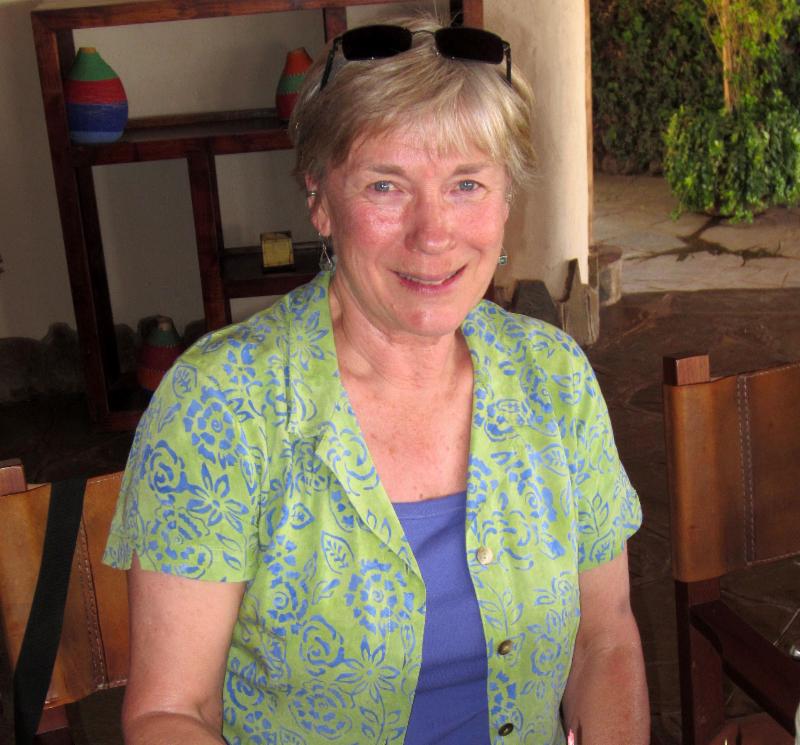
Prof. Phyllis Lee (ATE's Scientific Director) asks...
Care to Donate Now?
|
|
Norah Njiraini Rejoins the ATE Team
| |
We are so happy to welcome Norah back after an 18-month sabbatical. Her warmth and experience have been sorely missed, and we are delighted she is "home".
|
|
Sending Out Thanks
We have recently received several generous and much-appreciated donations. We would like to thank the following for supporting ATE and elephants:
Nick Nichols
World famous wildlife photographer Nick Nichols had an exhibition in Santa Barbara in October, and made a generous donation through the Santa Barbara Foundation to ATE from the proceeds.
Some of Nick's stunning photographs
East African Canvas
EAC donated a new tent for the research camp. This is hugely valuable for our field operations and will house research staff for many years to come.
East African's donation in situ
dBase LLC
One of the biggest challenges in maintaining long-term data is the changing technology. Collaborators and colleagues have done all kinds of interesting analyses over the years, but sometimes those programs are no longer accessible to us. dBase LLC have given us full and free access to their software suite to enable us to revisit some of these programs and build new analyses. It is a hugely valuable donation, as we look to future of our dataset and how it can be used to inform elephant management and conservation across Africa.
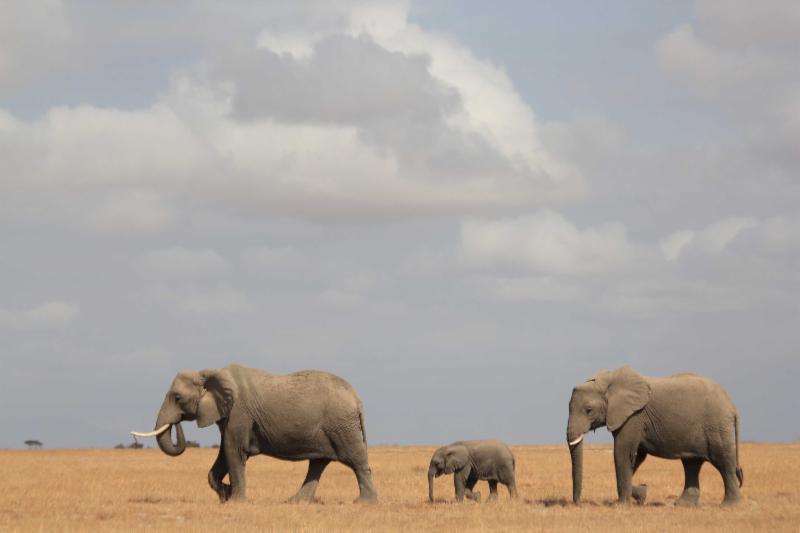 DB elephants to thank DBase DB elephants to thank DBase
| |
|
ATE Strategic Planning Meeting
|
The ATE 'core home team', comprising members of the Scientific Advisory Committee and the field research staff, held an intensive strategic planning session on 22 January. L to R standing: Katito Sayialel, Phyllis Lee, Cynthia Moss, Keith Lindsay, Vicki Fishlock, Norah Njiraini, Harvey Croze; kneeling, Joyce Poole, Tal Manor.
|
|
A Visit to the Lewa Elephants
|
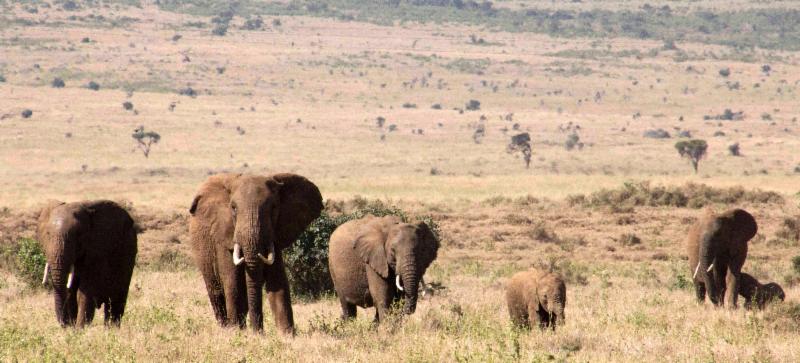 | |
A family in the gorgeous Lewa landscape
|
| |
Cynthia Moss and Vicki Fishlock visited ATE Board Member Susannah Rouse at the Lewa Wildlife Conservancy in Laikipia, Kenya. Aside from bringing Susannah up-to-date on ATE activities, we were also able to give some guidance on the elephant studies at Lewa.
|
Elephants Are Smarter than Anyone Thought |  |
Scientific American published two excellent online articles on the intelligence of elephants. We are pleased a prestigious science magazine has seen the light. Click Here and Here for the articles.
|
|
Name a Baby Elephant
Named calves Richter and Rea play and learn together in the RA family.
ATE has a naming program for donors. Since it is a very special privilege to name a calf we ask for a large donation of $2500. ATE's program is quite distinct from other adoption programs, where thousands of people might adopt the same animal. This calf becomes "your" calf and yours alone, and the name given forms a part of the Amboseli dataset for all time, even after elephants die.
With your donation you receive photographs of your calf, and a history of what we know about the family's triumphs and tragedies up until the birth of your calf. We also send periodic updates for exciting family events, such as the birth of a new sibling or playmate. Donors therefore follow the lives of calves over many years: The earliest donors who started with us when the program began in 1988 have now seen females give birth to calves of their own, and males become independent and begin to try and father calves of their own.
We know the joy of tracking elephant lives, following them as they grow, change and learn, and this program is a way of sharing that experience. Naming a calf creates a lifetime relationship with an individual wild elephant.
| |
|
The Court Case
We are hopeful that the case against Soila Sayialel and Robert Ntuawasa will be finalised very soon. The next court date is March 11.
| |
|
"Don't Buy Ivory" Bracelets
| |
We recently received a new order of bracelets. Think about ways to use these to spread the word and advocate for a ban on domestic sales of ivory products. If your group wants to help elephants, please contact Betsy Swart at this address.
|
|
iGive
One of the ways you can support ATE is by making your online purchases through iGive. If you sign up the Amboseli Trust for Elephants as your recipient organization we will get a small percentage of the sale. Connect with iGive.com.
| |
|
Give a Gift that Lasts Forever
| |
Designate the Amboseli Trust for Elephants as a beneficiary of your will, individual retirement account, or life insurance policy. Your legacy gift will enable ATE to learn more about the fascinating and complex lives of elephants and to assure their future.
To learn more about planned giving opportunities, please contact Betsy Swart at: info@elephanttrust.org; tel +1-508-783-8308.
|
Archive of Past Newsletters
Previous issues of the ATE newsletter can be found on our website at This Link.
| |
|
Newsletter Sign Up
| |
To sign up your friends for our newsletter and join our mailing list, please fill our the sign-up box on our Website: Click Here.
|
|
|
ATE Book Summaries
|
In this issue we continue the series of summary chapters from ATE's milestone volume, The Amboseli Elephants: A long-term perspective on a long lived mammal.
The compilation of three decades work continues be well-received:
"...we readily agree with the observation made by [editors] Cynthia Moss, Harvey Croze and Phyllis Lee in the introductory pages that 'elephants echo the human condition in so many ways that it is difficult not to become engaged in a manner that reaches beyond the confines of scientific enquiry.' And so it is that, when we put the book down, we do so with an increased awareness of the threats to the future of the Amboseli elephants and a commitment to contributing to their protection." -- Heidi Maclean
|
|
|
|
News from the Amboseli Trust for Elephants
January-February 2014
|
Elephants have been much in the news over the last few months and that news has mostly been disturbing, but there have also been many new and encouraging developments in efforts to conserve elephants. In the first story in this newsletter Resident Scientist Vicki Fishlock puts together a round-up of important recent events reports initiatives in the world of elephant conservation. The Amboseli elephants are blissfully unaware of the whirl of activity going on outside their ecosystem and in the halls of power. I am happy to report that things have been peaceful in our area. With relatively good rain falling in November and December the elephants gathered into huge groups and moved into and out of the Park in a leisurely, highly social fashion. I write about the phenomenon of big aggregations in the second article. The Amboseli elephants are very fortunate to share their range with a particular Maasai sub-group called the Ilkisongo. The whole of the larger elephant range outside the Park is occupied by the Ilkisongo Maasai. They have hosted the elephants for several hundred years and continue to show an outstanding desire to conserve their heritage, their habitat and the wildlife. Trustee Harvey Croze writes about the Amboseli Ecosystem Trust, a true grass-roots conservation initiative. Elephants are by no means safe, but more and more people and their governments are joining in to try to halt the slaughter. The only way to do so is to stop demand. We should no longer be talking about curbing the "illegal ivory trade". Elephants need nothing less than a ban on ALL trade in ivory forever. There can be no legal trade and no moratoriums.
Cynthia Moss
Director
Amboseli Trust for Elephants
|
|
 |
Elephant Conservation News Round-up -- Vicki Fishlock
The time is now for elephants, and the world media knows it. To write this article, I trawled through more than 200 elephant news stories since Jan 1
this year. While it can seem overwhelming, we think this media consciousness is vital for saving elephants.
Before we dive in, be warned that the positive language used in the media can mask some deep divisions within the conservation community. While everyone agrees elephants are in trouble, some parties are still talking of a moratorium (a temporary ban). Some are even talking of "legal trade" and stopping "illegal ivory" apparently ignoring the fact that a legal, regulated trade is exactly what has not been working since the stockpile sales of 1999 and 2008. It also ignores the links to international insecurity: recent estimates by Washington DC think tank the Stimson Center, suggest wildlife crime accrues $19 billion annually to terrorists and other criminals.
Good news includes strengthened legal protection for elephants, and new initiatives and agreements to tackle wildlife crime:
-
Kenya's Wildlife Bill - President Uhuru Kenyatta signed Kenya's new Wildlife Act into law on Dec 27, 2013. On Jan 28th the first prosecution imposed the full force of the new law, sentencing Chinese national Tang Yong Jian to a KES 20 million ($230,000), and a default seven-year jail term. Possession of or dealing in wildlife trophies without a permit is liable to a fine of not less than KES 1 million ($11,600), or a jail term of not less than 5 years. Offences related to endangered species are liable to a fine of not less than KES 20 million, or life imprisonment.
- USA Ivory Ban - In 2008 the USA was identified as the second largest ivory market after China. After the US Fish & Wildlife Service crushed six tons in November, there was a state-led impetus to ban ivory. Hawaii announced the first state ban on Feb 5th and New York State was set to discuss a ban. On Feb 11, the Obama administration announced federal level commitment to protect elephants with a national strategy for combating wildlife trafficking and a ban on the import, export, or resale of elephant ivory except in a very limited number of circumstances (full release here).
- WikiLeaks for Wildlife - The first global, secure online whistle blower platform dedicated to wildlife and forest crime was launched on Feb 7. We know that corruption and complicity severely hampers efforts to protect wildlife: this platform allows those with inside information to submit it anonymously and securely. Read more about how WildLeaks works Here.
- Stockpile Destruction - Destroying ivory stockpiles that accumulate through natural mortality and seizures of illegal trafficking sends a strong anti-trade message. In February France pulverised 3 tonnes, Chad burned 1.1 tons and Hong Kong pledged to destroy 28 tonnes over the next 2 years. The surprise decision of the year so far was by China, which crushed six tonnes of ivory on Jan 6th in Dongguan, a major hub for the ivory trade. The crush was the first official Chinese gesture of opposition to the trade, amidst mounting pressure from within China, as well as the international community.
- International Initiatives - In a high-profile meeting supported by Princes Charles, William and Harry, governments from around the world met to discuss wildlife trafficking. Delegates from 46 different countries and 11 UN organizations signed The London Declaration, committing to strengthening international collaboration to crack down on poaching and trafficking. The declaration also pledges to strengthen law enforcement and treatwildlife trade as a serious crime within the UN convention against transnational organized crime. The European Union has also voted in a resolution calling for tougher penalties and better training of police and prosecutors.
The bad... and the downright ugly:
- Counting the cost of poaching - Kenya's elephant population officially went into decline on Feb 11, when the Kenya Wildlife Service published count results for the Tsavo-Mkomazi ecosystem. Only 11,000 elephants were recorded, a loss of 1500 since the previous count. It is estimated that Tanzania has lost half its elephant population since 2007; the remaining could be wiped out in just seven years if current trends aren't reversed. Gabon and Congo released updated figures showing ongoing declines: Gabon has lost a third of its elephants in the past 10 years, and the Congo basin in general is estimated to have lost 65% of elephants in the past six years alone.
- South Africa continues its entrenched stance - South African Minister of Water and Environmental Affairs, Mrs Edna Molewa, did not attend the London symposium, but subsequently criticised the London Declaration for not clearly defending the principle of sustainable use. Many, including ATE, felt that the London declaration does not go far enough, but South Africa is insisting on its right to sell its wildlife, with plans to argue for the legalisation of rhino horn trade at the next CITES meeting.
-
Ugandan judiciary takes a backward step - A Ugandan court ordered the release of 2.9 tonnes of impounded ivory destined for shipment to China and the United Arab Emirates. Following the confiscation, the cartel of Ugandan, Congolese and Kenyan traffickers filed for a court order to compel the Uganda Revenue Authority to release the ivory, claiming it had been imported legally. The traffickers never appeared in court, and there was no documentation confirming the ivory entering into Uganda. Despite all that, high court judge Justice Musalu Musene ruled in the traffickers favour and ordered the ivory to be released for onward shipment.
ATE has joined with 22 other NGOs to demand a permanent ban on both domestic and international trade in ivory and the destruction of all government-held stocks. We therefore applaud the USA ban and the Elephant Protection Initiative.
All we think anyone needs to know is that ivory is meaningless and worthless without being attached to the face of a living, breathing, marvellous elephant.
|
|
Why are the Elephants in Such Large Groups? -- Cynthia Moss
Elephants live in a quintessential fission-fusion society. They come together, they split apart, they move in small sub-groups or massive aggregations of 400-500. On any given morning a female elephant might be in a small unit of three to four, composed solely of her own offspring. Later in the morning she might join her whole family and move in a group of 30. That group in turn might spend the day on its own or it might join other families and adult males. Towards the end of the day changes might occur again with a breaking down of the groupings. But those are just a few possibilities out of an infinite variety of association patterns.
My chapter with Phyllis Lee in our book The Amboseli Elephants details the dynamics of female social life (see Chapter 13 Summary below). In this article I want to talk about just one kind of association: the big aggregation, which happens to be my favorite elephant grouping and one that we have been seeing over the last two months.
There are many factors that determine with whom an elephant is going to associate in the short and long term and relatedness is the most important. Females live in families of related adult females and their calves and they will spend most of their lives close to these relatives. Environmental conditions also play a role. In the dry season when food is scarce and patchy, families will forage on their own and in the harshest years they will break down into mother-calf units. In a good wet season and particularly after the rains when the grasses are growing, the elephants in Amboseli will get into large aggregations consisting of 20 families or more along with 30 or 40 adult bulls. The largest aggregation I ever recorded was 550.
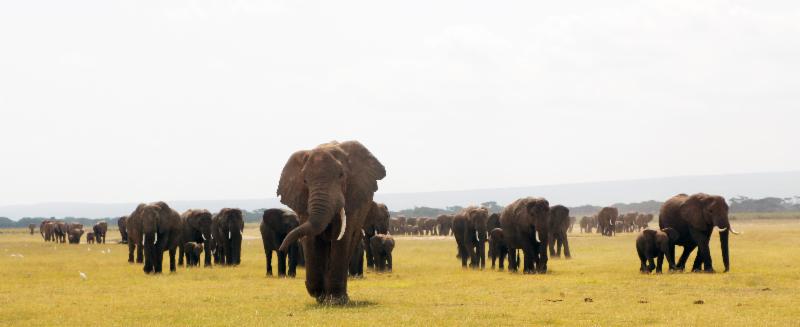
The phenomenon of aggregation does not occur everywhere in Africa, possibly because of habitat constraints, but in Amboseli it is a regular occurrence. In January of this year it was remarkable and I kept running into people asking what was happening in Amboseli, because they had never seen anything like it. One mother and daughter said they just sat and watched as wave after wave of elephants passed. It actually made them cry.
I can understand that emotion. It is a truly wonderful sight to see 300-400 elephants together. Added to the delight of the numbers is seeing them so relaxed and happy. It is no mystery to me why they get together. Elephants are supremely social animals and if conditions allow them to be together they will be. Big aggregations are important social arenas where relationships can be established or renewed, information can be exchanged, calves can play with new companions, young males can test each other's strength, big bulls can settle scores with rivals, males can find females who are ready to mate, and females can pick and chose the best mate.
Over the years I have discovered that it is impossible to collect any systematic data in aggregations. They are simply too huge and too much is going on. I just put my pen and paper down and enjoy being with them.
There is no place better than Amboseli to see this kind of phenomenon. I recommend January-February and May-June for seeing elephants living their rich social lives the way they should be.
|
 |
Amboseli Ecosystem Trust
-- Harvey Croze
 | |
Amboseli Ecosystem Trust Board Members review progress, plan future
|
These days elephant-watchers have little about which to feel optimistic. But I came away from observing the February meeting of the Amboseli Ecosystem Trust (AET) Board of Trustees feeling cautiously elated.
AET (not to be confused with us, ATE) is an incorporated trust of senior Maasai community members, who have come together spontaneously to forge a united front against destruction of the greater Amboseli ecosystem (essentially the range of the elephants).
The Trust has drafted an Amboseli Ecosystem Management Plan and is commissioning a Strategic Environmental Assessment. The Board is chaired by ATE's good friend and ally, Daniel Leturesh, who is the long-standing chairman of Olgulului/Lolarashi Group Ranch, the formal structure of the Maasai clan that lives immediately around Amboseli National Park.
Historically, of course, Amboseli and the elephants have enjoyed effective protection from the bulk of poaching infecting elephant populations throughout their range by the presence of two watchful groups, both of which are vehemently intolerant of destructive elements in the ecosystem: the Maasai community and the wildlife researchers. The Kenya Wildlife Service, official custodians of Kenya's wildlife, has said on more than one occasion how helpful to it are the on-the-ground groups. Amboseli's Senior Park Warden, Julius Cheptei, is a member of the AET.
Today, as the group ranch fabric is unravelling due to land adjudication, the Maasai have realised that they need a strong, well-organised body of respected community leaders to plan for the future of the ecosystem and to hold the battlements against land fragmentation and grabbing, uncontrolled development, blocks to wildlife and livestock movements, fouling of water resources and iniquitous abstraction, overgrazing, mounting country-wide insecurity, and wildlife poaching.
Not surprisingly, AET is supported and encouraged by a number of NGOs working in the ecosystem, such as the African Conservation Centre, The Amboseli Conservation Program, the International Fund for Animal Welfare, the African Wildlife Foundation, the Big Life Foundation, the Lion Guardians and ATE.
It was the impressive level of the discussion around the board table and the evident commitment of the leaders to strategic action to protect their heritage and livelihood that gave at least one old cynical conservationist a glimmer of hope for the future of the Amboseli ecosystem.
|
The History of the YA Family
The YA family is one of the smallest in Amboseli and it has remained small since the beginning of the study. Actually when I first recorded them in 1975, at six members they were close to the average family size. Today with families numbering 40-60 members it seems almost impossible that the average family size was seven in the 1970s. 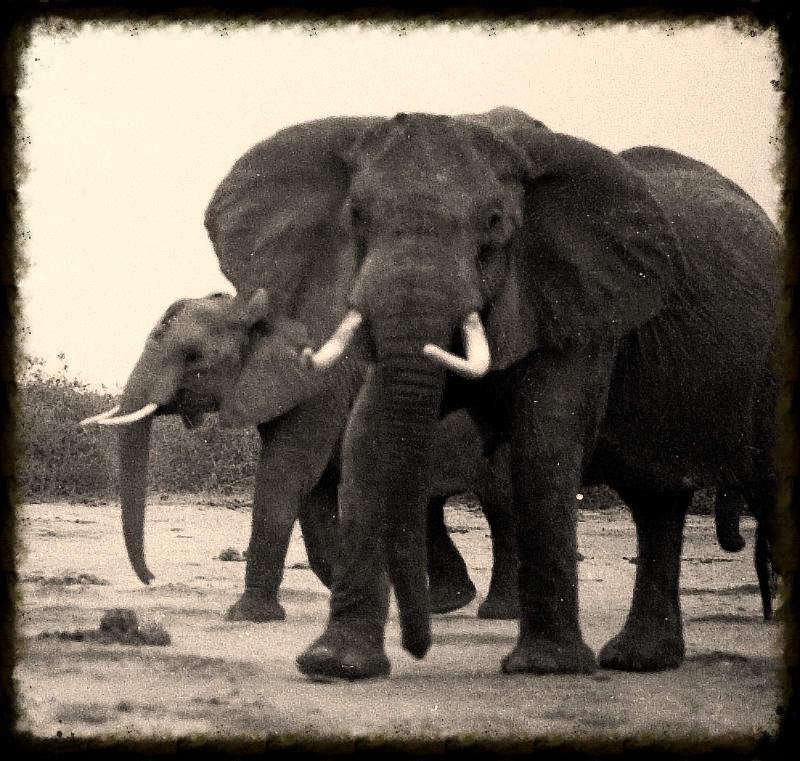 | |
Big, beautiful Yolanda in 1975
|
I met the YAs for the first time on August 17, 1975 and found them again the following month and on this occasion I got a good look at them. There was a big, handsome female who appeared to be in her early 50s. A second younger female was about 30 years old and I assumed she was the big female's daughter. With them were four calves under 10 years old. I assigned them the letter 'Y' and named the two adult females. I decided that the family consisted of the following:
Yolanda adult female around 50
Male calf 4-5 years
Ysolde adult female around 30
Male calf yearling
6-8 year female
8-10 year male
I recorded the Y family two more times in 1975 and on each of the sightings for that year the Ys, who eventually became the YAs when we went through the alphabet a second time, were close to the JA family led by Jezebel and the SA family led by Sona. These three families appeared to form a bond group whose home range was in the western part of Amboseli. There are 58 family units in the Amboseli population. Each is led by the oldest female, the matriarch. There was no doubt that the matriarch of the YAs was Yolanda. |
Amboseli Book Chapter Summary, 13: Female Social Dynamics
The largest and one of the longest-lived mammals on Earth has a fittingly large and complex social world. The multi- tiered social life of female African elephants is based on relationships that radiate from an individual and her immediate offspring out through other family members, bond group members, clan members, and sub-population members to the whole population and even further, to strangers.
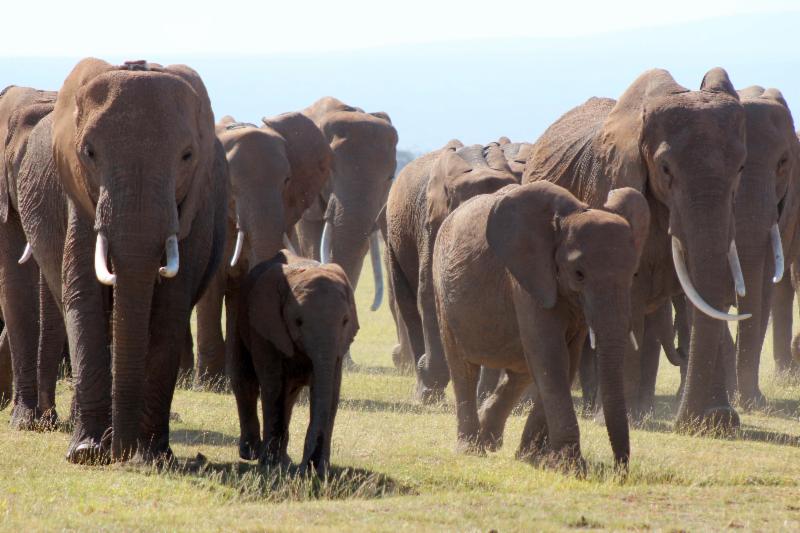
Males live an almost entirely different social life once they reach independence but have an equally large network of relationships throughout the population and beyond.
In Chapter 13, Female Social Dynamics: Fidelity and Flexibility, by Cynthia J. Moss & Phyllis C. Lee, we describe female elephant social organization and dynamics at the individual, family, and bond group levels in the Amboseli population and examine both the consistency and changes that have occurred over a period of 30 years. By analyzing association and grouping patterns among female elephants, we demonstrate the natureof the flexible fission-fusion society that allows for individualresponses to environmental, demographic, and socialconditions. Although many of these responses are based oncosts and benefits for the individual, the social responsesof elephants are far more complex than those predicted bya simple cost-benefit analysis at a single point in time. Femalesmake social decisions over long periods of time as well as respond to social and ecological opportunities andconditions on a day-to-day and even an hour-to-hour basis.
|
|
|
This is a new year and after a very difficult 2013 we are feeling positive about the future of the Amboseli Trust for Elephants and most important about the future of the elephants themselves. The threat to elephants everywhere is still huge but the world has woken up to their plight. We don't for a moment think their future is assured, but we are going to keep fighting until we get what we believe is necessary: NO TRADE FOREVER. Please help us to help the elephants.
Cynthia Moss
Amboseli Trust for Elephants |
|
|